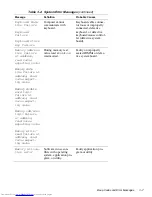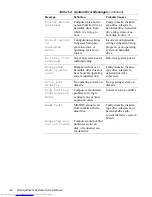
Basic Troubleshooting
2-5
•
PIC Test — Generates an interrupt on each IRQ line to verify interrupt con-
troller operation
•
Speaker Test — Checks the functionality of the speaker by generating tones
•
Video Tests — Verify proper operation of the video controller and the video
control circuitry
•
USB1 Tests — Check the USB interface registers and the USB controller
•
Serial Port 1 Tests — Check the computer’s interface with external devices
connected through serial port 1
•
Serial Port 2 Tests — Check the computer’s interface with external devices
connected through serial port 2
•
Parallel Port 1 Test — Checks several internal functions of the parallel port
•
Mouse Test — Checks the functionality of the mouse controller and the
operation of the mouse keys
•
Keyboard Tests — Verify the correct operation of the keyboard and the key-
board controller chip
•
Disk 0 Tests — Check the hard-disk drive controller and the storage capa-
bility of the hard-disk drive
For a complete description of the server-based diagnostics, see “Server-Based
Diagnostics” in the online Network Administrator’s Guide.
H
ard-Disk–Based Diagnostics
The hard-disk–based diagnostics contains tests that aid in troubleshooting all
major components of the computer. If it is not possible to run the server-based
diagnostics, or if the server-based diagnostics fails to reveal the source of a sus-
pected hardware problem, run the hard-disk–based diagnostics by following
these steps:
1. Turn on (or reboot) the system.
2. Press <Ctrl><Alt><F10> immediately after you see the following
message:
Press <Ctrl><Alt><Enter> for Setup
If you wait too long and the operating system begins to load into memory,
let the system complete the load operation; then shut down the system and
try again.
Starting the diagnostics causes the Dell logo to appear on the monitor
screen, followed by a message indicating that the diagnostics is loading.
Before the diagnostics loads, a program tests the portion of main memory
(RAM) required for loading the diagnostics. If a main memory error is
detected, a message indicates which DIMM has failed. If no errors are found
in main memory, the diagnostics loads and the Diagnostics Menu appears.






























